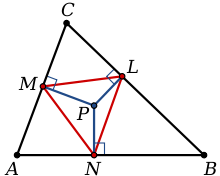Pedal triangle
In geometry, a pedal triangle is obtained by projecting a point onto the sides of a triangle.

More specifically, consider a triangle ABC, and a point P that is not one of the vertices A, B, C. Drop perpendiculars from P to the three sides of the triangle (these may need to be produced, i.e., extended). Label L, M, N the intersections of the lines from P with the sides BC, AC, AB. The pedal triangle is then LMN.
The location of the chosen point P relative to the chosen triangle ABC gives rise to some special cases:
- If P = orthocenter, then LMN = orthic triangle.
- If P = incenter, then LMN = intouch triangle.
- If P = circumcenter, then LMN = medial triangle.

If P is on the circumcircle of the triangle, LMN collapses to a line. This is then called the pedal line, or sometimes the Simson line after Robert Simson.
The vertices of the pedal triangle of an interior point P, as shown in the top diagram, divide the sides of the original triangle in such a way as to satisfy Carnot's theorem:[1]
Trilinear coordinates
If P has trilinear coordinates p : q : r, then the vertices L,M,N of the pedal triangle of P are given by
- L = 0 : q + p cos C : r + p cos B
- M = p + q cos C : 0 : r + q cos A
- N = p + r cos B : q + r cos A : 0
Antipedal triangle
One vertex, L', of the antipedal triangle of P is the point of intersection of the perpendicular to BP through B and the perpendicular to CP through C. Its other vertices, M ' and N ', are constructed analogously. Trilinear coordinates are given by
- L' = − (q + p cos C)(r + p cos B) : (r + p cos B)(p + q cos C) : (q + p cos C)(p + r cos B)
- M' = (r + q cos A)(q + p cos C) : − (r + q cos A)(p + q cos C) : (p + q cos C)(q + r cos A)
- N' = (q + r cos A)(r + p cos B) : (p + r cos B)(r + q cos A) : − (p + r cos B)(q + r cos A)
For example, the excentral triangle is the antipedal triangle of the incenter.
Suppose that P does not lie on any of the extended sides BC, CA, AB, and let P−1 denote the isogonal conjugate of P. The pedal triangle of P is homothetic to the antipedal triangle of P−1. The homothetic center (which is a triangle center if and only if P is a triangle center) is the point given in trilinear coordinates by
- ap(p + q cos C)(p + r cos B) : bq(q + r cos A)(q + p cos C) : cr(r + p cos B)(r + q cos A).
The product of the areas of the pedal triangle of P and the antipedal triangle of P−1 equals the square of the area of triangle ABC.
References
- Alfred S. Posamentier; Charles T. Salkind (1996). Challenging problems in geometry. New York: Dover. pp. 85-86. ISBN 9780486134864. OCLC 829151719.